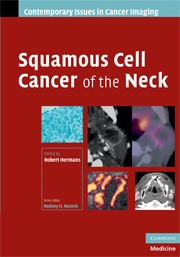Book contents
- Frontmatter
- Contents
- List of contributors
- Series Foreword
- Preface to Squamous Cell Cancer of the Neck
- 1 Introduction: epidemiology, pathology and clinical presentation
- 2 Radiotherapy and chemoradiotherapy of the head and neck
- 3 Surgery of the orocervical region
- 4 Laryngeal and hypopharyngeal cancer
- 5 Oral cavity and oropharyngeal cancer
- 6 Nasopharyngeal cancer
- 7 Neck and distant disease spread
- 8 Post-treatment imaging
- Index
- Plate section
- References
2 - Radiotherapy and chemoradiotherapy of the head and neck
Published online by Cambridge University Press: 24 August 2009
- Frontmatter
- Contents
- List of contributors
- Series Foreword
- Preface to Squamous Cell Cancer of the Neck
- 1 Introduction: epidemiology, pathology and clinical presentation
- 2 Radiotherapy and chemoradiotherapy of the head and neck
- 3 Surgery of the orocervical region
- 4 Laryngeal and hypopharyngeal cancer
- 5 Oral cavity and oropharyngeal cancer
- 6 Nasopharyngeal cancer
- 7 Neck and distant disease spread
- 8 Post-treatment imaging
- Index
- Plate section
- References
Summary
Introduction
Radiation oncology plays a major role in the treatment of cancers of the head and neck. It can be used as the only treatment modality or as an adjuvant treatment in combination with surgery. In recent years, it has been frequently used in combination with chemotherapy, mainly to preserve organ function.
In the last decades, important advances in the delivery of radiotherapy have been made, making it possible to deliver high doses of radiation to the tumor, while maximally sparing the surrounding tissues. These developments imply, however, a very accurate delineation of the tumor-involved tissues, which can only be made via the use of imaging techniques.
(Chemo)radiotherapy in head and neck cancer
Selection of a treatment modality
Selection of a treatment modality for head and neck cancer should be based on the size and location of the primary tumor, the status of the regional lymph nodes and the general condition of the patient. Early head and neck cancers are usually treated with one modality – either surgery or radiation therapy. The choice between surgery and radiation therapy in these cases is usually determined by the functional deficit that would result from each treatment modality, since both result in similar rates of local control and survival. Cancers at a locally advanced stage can be treated with a combination of surgery and (chemo)radiotherapy or with primary (chemo)radiotherapy. Chemoradiotherapy can be used when organ preservation is feasible, with surgery as an optional salvage treatment.
- Type
- Chapter
- Information
- Squamous Cell Cancer of the Neck , pp. 19 - 34Publisher: Cambridge University PressPrint publication year: 2008



